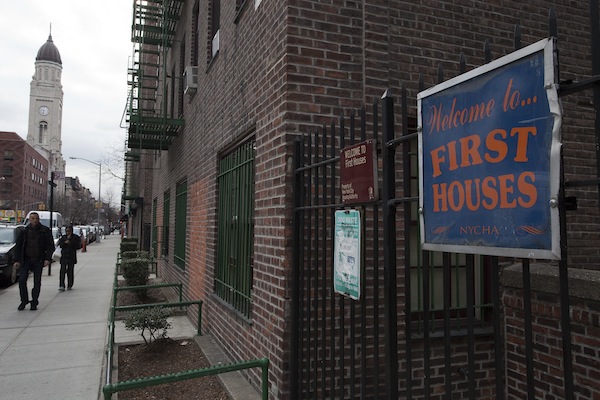
Photo by: Marc Fader
First Houses, on the Lower East Side, is where public housing began in the United States. New York is the only city to create its own public housing, and New York is one of only four states to have its own public housing program, on top of the federal one.
New York’s public housing authority is hoping to enroll in a national program that will provide it with budgetary flexibility. But advocates for the authority’s half-million residents are pressing for assurances that the move will not threaten tenants’ rights.
At his agency’s annual City Council budget hearing, New York City Housing Authority Chairman John Rhea said that, outside of New York and Los Angeles, virtually every large public housing entity in the country has adopted the Moving to Work program.
“Philadelphia, D.C., Boston. You go down the list, they all have it Chicago,” Rhea told the Council’s committee on public housing. “These are obviously large metropolitan areas in the United States. They all have funding flexibility.”
Moving to Work (MTW) would free NYCHA—which federal penny-pinching has left with a multi-billion-dollar backlog of capital projects and eight-figure operating deficits for each of the next several years—from several budget restrictions. Under MTW, NYCHA could, for instance, mix two separate federal funding streams for traditional public housing and Secion 8 to offset shortfalls in one program or the other.
Flexibility, or the lack of it, underlies several issues on NYCHA’s plate these days:
But MTW’s flexibility is controversial because other housing authorities have used the program to get wiggle room not just on bookkeeping practices, but also on important tenant rights. Agencies have lifted limitations on rent, imposed work requirements and implemented time limits.
Because of its potential to erode essential tenant protections, MTW has long been controversial for NYCHA, the nation’s first and largest public housing authority. Rhea recently re-convened a working group of tenant advocates formed when MTW was last contemplated five years ago to assure them that the authority has “no intent” to implement work requirements or time limits. But the chairman’s assurance was not a guarantee that NYCHA would never adopt those policies.
“We can’t give you those hard and fast assurances,” he told the committee Monday. “What we can tell you is what our current intent and plan is.”
But tenant advocates are looking for just those kind of assurances, or at least a process that considers more carefully each of the major policy shifts NYCHA is contemplating.
“The financial flexibility that comes with participating in MTW should not come at the cost of tenant rights and protections,” testified Lucy Newman of the Legal Aid Society. “We’d really like to see an agreement from NYCHA in an enforceable form like [a memorandum of understanding] that would bind NYCHA and future administrations.”
For his part, Rhea said that any policies adopted under MTW would be codified as part of the authority’s annual plan. But Victor Bach, a housing analyst at the Community Service Society (which owns City Limits), said that the annual plan process—which revolves around a three-hour public hearing—wasn’t built for considering the kinds of existential changes NYCHA is contemplating.
“NYCHA is a city of 600,000 residents,” Bach noted. “It’s not sufficient accountabilty for NYCHA simply to fold in any of these proposals into its annual plan process. There’s simply not time to hear them.”
Advocates called for special public hearings on each of the major policy shifts NYCHA is considering, even if that goes beyond what is required by federal law.








